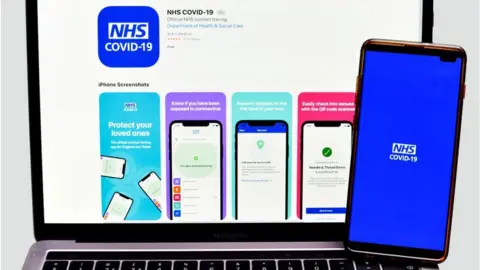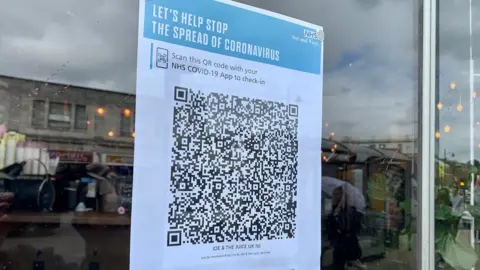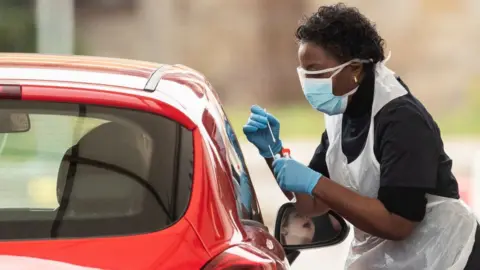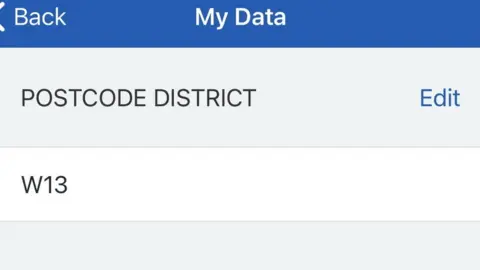NHS Covid-19 app: 12m downloads - and lots of questions
 Getty Images
Getty ImagesThe Health Secretary Matt Hancock has said the NHS Covid-19 app had been downloaded 12.4 million times as of noon.
The contact-tracing app - covering England and Wales - launched on 24 September.
The Department for Health and Social Care has emphasised that using it is voluntary.
It also says the guidance the app issues about whether to self-isolate or get a test is not enforceable by law.
The app itself may look simple, but it has thrown up lots of questions about how it works and what its limits are.
Here's our attempt to answer some of your queries:
Why can't I log out of a location after I've logged in?
One feature of the app is its ability to scan a QR barcode to log in at a pub, restaurant or other location - an alternative to actually handing over your contact details to that business on a paper log, website or alternative system (though in Wales you still need to do both).

But people have noticed that while you can log in you cannot log out, and even if you soon leave the app thinks you are still there until midnight unless you log in somewhere else.
The point however of the QR scan is just to register your presence at that location rather than your proximity to someone infectious, which is registered via the Bluetooth contact-tracing feature.
If the location is later identified as a virus hotspot then an alert may be sent out to anyone who scanned a QR code there - not to self-isolate, but to be on the lookout for any symptoms of the virus.
But you cannot be alerted that somebody arrived in the pub hours after you left, and they later tested positive, because your phones could not have been physically close to each other at the same time.
Why can't I input a negative test result?
On Friday it emerged that some test results were arriving without the code needed to register them in the app. By Saturday evening the Department of Health said codes would now be provided with all positive test results, via a phone call from the contact tracing team.
 Getty Images
Getty ImagesBut some are asking why there isn't a code for a negative result, especially as a self-isolation countdown begins as soon as someone registers that they have symptoms.
There seem to be a couple of answers. If you've been told to self-isolate because you have been in contact with an infected person, then you are supposed to do so regardless of whether you test negative yourself.
If you are the potentially infected person, then nobody will be notified via the app without a positive result. However, it does mean you have to live with the timer as it cannot be de-activated - but as we said, adhering to this is not legally enforceable.
Then there's the fact that the intention is that you now arrange your test via the app after reporting symptoms. In this case, the results - positive, negative or void, (which means a retest is needed) - will be registered automatically in the app without any need to enter a code.
Why doesn't the location change when I move around?
When you first download the app it asks for part of your postcode. You then get a message on the homescreen telling you what the risk level in your area is.
Why doesn't this change when you move somewhere - for instance when a student leaves home to go to university?
Right at the beginning of the app's development, privacy campaigners expressed concern about the government tracking people - and a promise was made that location tracking would not be a feature of this app.
There is however a way of changing that postcode without reinstalling the app. Go to "About this app", then "Manage my data" and you will then be able to edit your postcode.
 NHS
NHSWhy doesn't it work on my phone?
A number of people - in particular those with iPhones earlier than the 6S which went on sale in 2015 - are finding that they are unable to install the app on their phone.
This is not due to a decision by the app's developers but is a limitation imposed by Apple and Google. They have designed the toolkit on which this and many other contact-tracing apps around the world are based - and they have determined that older phones would not be suitable for running the technology behind the app.
The tech companies say that older phones cannot run the Bluetooth technology required by the app effectively.
I get notifications which then disappear - what's going on?
A number of people have reported getting notifications about exposure to the virus and then not being able to find out what they need to do next.
Some are confused because of the way they are written - including the phrase "exposure date, duration and signal strength have been saved".
It appears that this again may be connected to the Apple-Google system, which sometimes sends out what are called exposure notifications. Here's what the FAQ from the app team says about this issue:
"These are default messages from Apple and Google. There is no need to be concerned if you miss or overlook them, they are just visible to remind you that the functionality is on and working. You're currently not able to turn off these default Apple and Google notifications.
"Important messages from the NHS Covid-19 app will always be visible to you from inside the app."
Like other apps, NHS Covid-19 will get updates and new features. And the NHS is inviting people to send in any feedback about problems they have faced or features which could improve the app.
